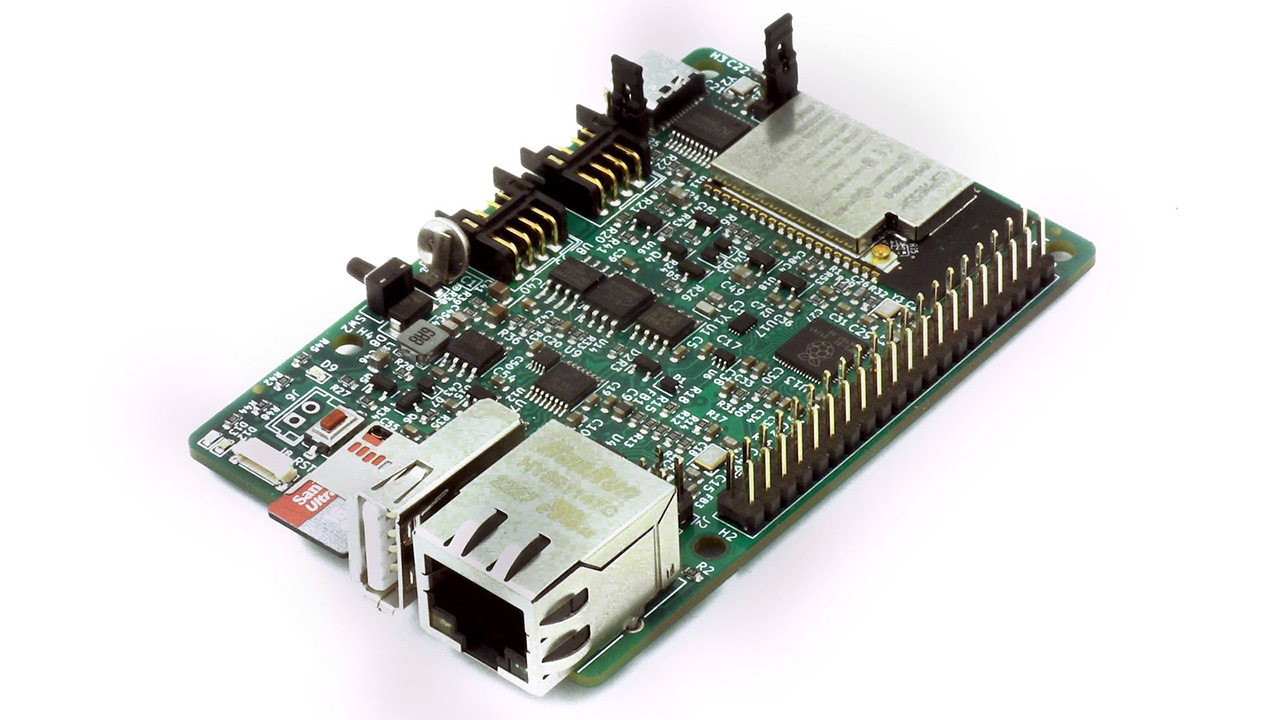Crowdfunding Board Has ESP32 and Raspberry Pi Pico Working Together
The Best of Both Worlds
It looks like a Raspberry Pi 4, but this board contains both an ESP32 and the Raspberry Pi Pico's RP2040 microcontroller. Normally these microcontrollers tend to come in tiny packages that allow them to be built into the tight spaces that electronics projects often contain. Something the size of a Raspberry Pi 4 might be considered too big, but that hasn’t stopped the German engineers from MDC-Service Wittenburg GmbH on Crowd Supply, who are about to launch a combination ESP32 and RP2040 controller in the Raspberry Pi 4 form factor.
Known as the EsPiFF, there's a combination of dual-core ESP32-WROVER and RP2040 humming away at its heart, with the latter acting as a co-processor to bridge the divide between ESP32 and Pi-compatible HATs.

The unusual board shape means it can be placed inside some Raspberry Pi case - of which there are many choices - but the unusual port layout means that only a few will be compatible. The board can take Pi HATs too as there's a 40-pin GPIO array just like on the real thing. The 40 pin GPIO is claimed to be compatible with HATs, and connects the RP2040 to the HATs. It remains to be seen how effective this is.
You also get 8MB of PSRAM, 8Mbit of high-speed ISSI flash and 16MB of other flash, with an unpopulated header for 512Mbit more of storage, and there's a Micro SD card socket for even more capacity. Connectivity is dealt with via Wi-Fi (which requires an external antenna, unlike the Raspberry Pi Pico W) and 10/100 Ethernet - there's a header for POE too, if a HAT requires it.
Power is delivered via a USB-C port, just like on the Pi 4, and there's a USB-A port for data transfer. The Type-A port and Micro SD card slot are at the opposite end of the board to the Pi 4, and will need to be accessed through the USB port access holes in a case. The Ethernet and Type-C ports are in exactly the same places, while a reset button pokes through the audio output hole. There are supercaps for power retention, up to three UARTS for serial connections, and an external realtime clock, watchdog, and supervisor for high-availability, 24/7 applications.
As it uses a small amount of power and needs no heatsink, the board would be a good choice for measurement, control, and automation projects Software support comes in the form of Apache Nuttx RTOS, and the EsPiFF can be programmed with Espressif IDF, Arduino, and other ESP32 development tools. The project is completely open source, and all files can be found on GitHub.
Remember that crowdfunding a project is not a guarantee of receiving a finished product. Backing a crowdfunded project is akin to an investment, you believe in the project and want it to succeed. You are not purchasing a retail product.
Get Tom's Hardware's best news and in-depth reviews, straight to your inbox.

Ian Evenden is a UK-based news writer for Tom’s Hardware US. He’ll write about anything, but stories about Raspberry Pi and DIY robots seem to find their way to him.
-
ventrig Very interesting combination. Is there a preliminary data sheet available? When and where would I be able to buy one?Reply -
EsPiFF Reply
Hi there,ventrig said:Very interesting combination. Is there a preliminary data sheet available? When and where would I be able to buy one?
we have now a preliminary datasheet for the version 3.1: https://github.com/MDCservice/EsPiFF/blob/main/datasheet_v3_1.pdf
Please be advised, that the version we sell over the crowdsupply campaign, will be the version 3.2, what adds a few more features over the 3.1, particular
addition of 8 MBit ISSI high end SPI flash,
addition of the footprint for up to 512 MBit ISSI high end SPI flash,
footprint for a JTAG header for kernel developers.
The board can be bought via the crowdsupply campaign (https://www.crowdsupply.com/mdc-service-wittenburg-gmbh/espiff), what will soon receive orders. Please subscribe there, to get notified about the price and starting date.
BR,
Michael -
EsPiFF Reply
Hi Ian,Admin said:EsPiFF merges the powerful RP2040 with the venerable ESP32 into the Raspberry Pi 4 form factor for an intriguing microcontroller platform.
Crowdfunding Board Has ESP32 and Raspberry Pi Pico Working Together : Read more
thank you for the great article about the EsPiFF. We have now an annotated picture showing all the functionality on the EsPiFF board, as well as a preliminary datasheet. -
EsPiFF Hi there,Reply
The PCB antenna of the ESP32-WROVER is disconnected by factory default. An external antenna with a uFL connector is included in our package.
Unfortunately there is no ESP32 module available with 16 MB Flash, 8 MB PSRAM and MII Ethernet, without a PCB antenna.
That's why we choose the ESP32-WROVER-IB, what have a PCB antenna and the uFL connector.
We are constrained by the Raspberry Pi's PCB size and had to make the decision to keep the Pi form factor or have the antenna protrude above the board.
This would break the compatibility with RasPi enclosures.
We will update the datasheet to mention the external antenna.